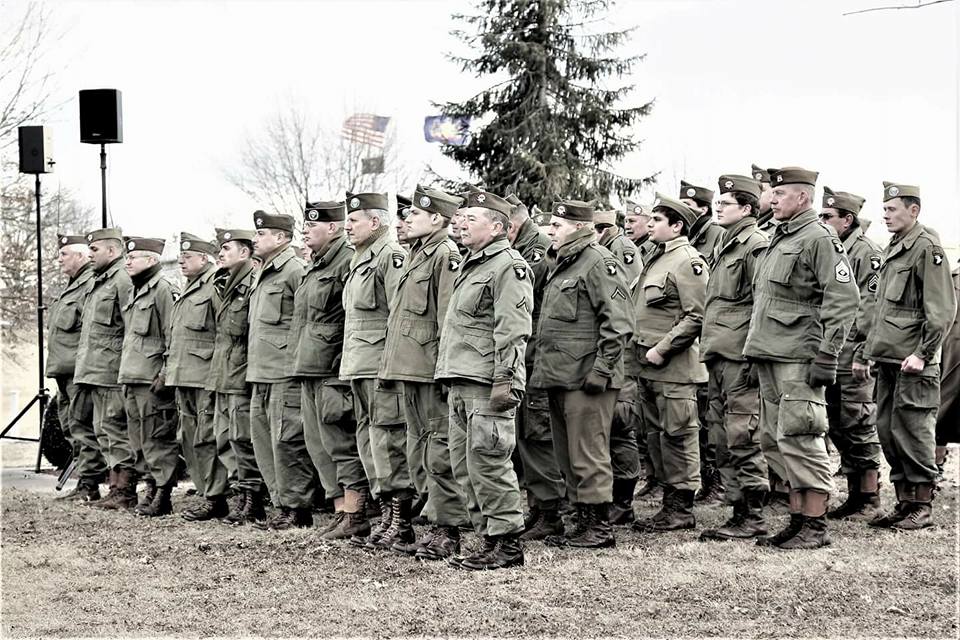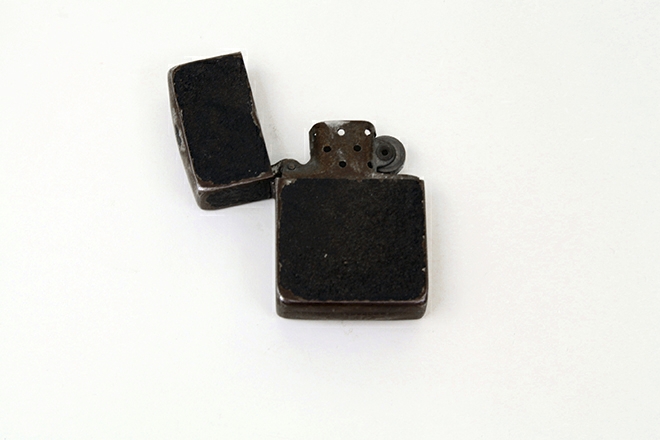Equipment Descriptions |
|
| This list is intended to give the new recruit an idea of the equipment required in order to authentically portray an Airborne Paratrooper during various fazes of WWII. This is not an exhaustive list, but rather the "essential list" of items needed for one of those phases. | |
D-Day |
|
Corcoran Jump BootsThe top image at right shows a pair of brand-new Corcoran 10 Inch Historic Brown Leather Jump Boot (mfr.#: 1510), which is made by the same company which produced the boots in the 1940's. The second image shows a pair of original WWII boots after being used in service and maintained in almost identical condition as when they left the battlefield in 1945. |
|
Double Buckle Rough-Out Boots
|
|
 |
M1942 Uniform
|
 |
M1943 Uniform
|
CompassesTwo types of compasses were issued for D-Day soldiers. A larger model was made especially for paratroopers, and was worn on one’s wrist. And then there was a class of much smaller compasses that could be, well, hidden just about anywhere. On the left is one of the wrist models manufactured by a company called Superior Magneto. Officially, the compass was called “Compass, Wrist, Liquid-Filled.” The body is made of Bakelite plastic, and the needle tip was at one time luminescent. The white arrow on top is painted directly on the glass bezel. The other three compasses were sourced from survival kits -- also known as “escape and evasion kits,” which we describe in the next slide. These devices were nowhere near as accurate as the wrist compasses, but were still useful if you needed to find your general bearings in a pinch. And because they were so small, they could be easily concealed in the event of capture. In fact, the escape compass came to be known as the “asshole compass.” Draw your own conclusions. |
|
Escape & Evasion KitDuring the war, airborne officers were issued escape and evasion kits that contained a small compass (see previous slide), a tiny steel hacksaw in a cardboard container, a two-sided map made of Rayon (often misidentified as silk), and sometimes currency appropriate to the location of the soldier’s mission. Here we see a vivid example of an escape map, along with the pouch it came in. Because the map was made of Rayon and not paper, It wouldn’t become an unreadable, crinkled-up mess after multiple foldings and unfoldings. Nor would it fall to pieces in the rain. Czekanski says that because the map shows southern France and not Normandy, he can’t be sure that it was actually deployed on D-Day. To this end, we’re thinking it could have been issued for Operation Dragoon, the 1st Airborne parachute invasion of southern France on Aug. 15, 1944, some two months after D-Day. Nonetheless, the kit’s pouch clearly denotes that maps for areas “C” and “D” are inside, and according to a Veterans Footlocker sale of an ostensibly identical escape and evasion kit, “The C/D maps were used for the invasion of Normandy.” Veterans Footlocker also states that escape and evasion kits were given to “advanced infantry personnel” (and not just paratroopers) and the C/D maps it had on sale were issued to a scout in an armored unit. The pouch reads “Maps Only” for a very specific reason -- it signals that no money was stuffed inside. You see, any money included in one of these kits had to be accounted for by an army quartermaster, says Czekanski. This involved a lot of tedious opening and closing of canvas pouches, every time a pouch was returned to inventory. So, by defining the pouch as “Maps Only,” the kit was saved unnecessary scrutiny. |
|
Equipment Bundle Light“A real sweet piece of gear,” says Czekanski. “It’s basically a flashlight that was clipped on to the equipment bundles held under the belly of an airplane. The bundles held extra weapons, food, and medical supplies. The planes dropped the bundles ahead of the troops, and the paratroopers could follow the lights to rapidly locate equipment. They came in different colors based on what was in the bundle -- red meant ammunition.” The lamp was powered by two C-cell batteries, and was turned on automatically by a rip cord as the equipment bundles parachuted down from the airplane. Though the labeling is scratched off in our photo, a cleaner specimen on historian Mark Bando’s D-Day site reads “Lamp Assembly Identification Aerial Delivery Container,” manufactured by Standard Aircraft Products, Inc of Dayton, Ohio. |
|
M1 GarandDesigned by John Cantius Garand in 1932, the M1 was the primary weapon for most U.S. soldiers throughout World War II. It shot .30-'06 bullets from an eight-round clip, and a paratrooper might typically jump with 136 total rounds of ammunition. The rifle had a maximum effective range of 440 yards, but could still do damage in excess of 1,000 yards. But what really made the Garand so effective was its semi-automatic firing. Where the Germans had bolt-action rifles that required the movement of a handle to release spent cartridge casings, the Garand’s trigger could be fired eight times in quick succession. This allowed American soldiers to focus on target acquisition rather than laborious rifle U.I. The bayonet in the photo is actually a trimmed down version of the 16-inch M1905 bayonet that was used in World War I. At the end of the first war, the army had a huge stockpile of remaining bayonets. To deploy them for use with the M1 Garand, the government simply cut them down to 10 inches, and reground their edges. The motivation? To produce a more efficient weapon, and to conserve precious steel. According to the Garand Collector’s Association, 1,007,671 16-inch bayonets were converted for use with the M1 during World War II. |
|
Folding Stock M1A1 CarbineBy definition, a carbine is a shorter, lighter version of a full-length rifle. In the case of the M1 carbine, it was designed to replace handguns for the wide variety of soldiers who, for one reason or another, weren’t issued full-fledged rifles. This might include radio men, forward observers, and vehicle drivers, as well as the soldiers who served on the multi-man teams operating mortars and Browning light machine guns. The troops charged with “crew-served” weapons weren’t expected to frequently engage the enemy in face-to-face combat, but everyone still needed his own gun, so these guys were issued carbines. The M1 carbine was semi-automatic and used the same .30 caliber bullet diameter of the ammunition for the M1 Garand, but the bullet itself was smaller than the round spec’d for the beefier gun. Carbine magazines carried 15 rounds. The carbine offered neither the range nor the stopping power of the Garand, but it was less cumbersome to carry (a significant benefit if you were already hauling parts of a crew-served weapon). It was also easier to aim than a handgun. Nonetheless, many soldiers switched out their carbines in the field for heavier firepower. As Bando writes on his website, “They lacked knockdown power, even at short range, and were frequently discarded in disgust.” In our photo, we have the M1A1 version of the carbine. It was manufactured by Inland, a division of General Motors, and was made especially for D-Day paratroopers. The A1 version had a pistol grip, as well as a metal buttstock that folded up neatly against the side of the gun, as seen in our photo. the M1A1 came in a pouch that hung off the paratrooper’s belt as he jumped from his plane. |
|
Cricket Noise MakerThe original cricket noise maker was a child’s toy made by the ACME Whistle Company in England. But for D-Day, paratroopers were issued much more serious brass versions. With soldiers scattered willy-nilly behind enemy lines, the troops needed some type of stealth audio signal to identify each other in the dark of night. Operation was simple: If someone approached, you clicked your cricket, making the most innocuous of night-time sounds. If the passer-by clicked back, you knew you had encountered a friendly comrade. “Not everyone had them. They didn’t have enough to go around,” says Czekanski. “But they were probably used quite a bit. It was so dark, and the terrain had so many hedgerows and bushes and walls. It was a lot safer to click than call out.” |
|
Entrenching Tool #1Foxholes didn’t just dig themselves. Soldiers dug them out with an entrenching tool, or e-tool. Some had a folding blade, and others even added a pick to the folding assembly. But the model shown here is a simple “T-handle” version with a fixed blade. “I’m not sure how many guys actually parachuted with entrenching tools,” says Czekanski. “It’s more typical of what guys brought ashore. Toward the end of the war they got a shorter shovel. It was all a matter of what your army thought you needed most.” |
|
Entrenching Tool #2
|
|
Mk 2 Grenade and Gammon BombTwo high-explosive weapons were issued to D-Day soldiers. The Mk 2 pictured on the left is often referred to as a “pineapple grenade,” for obvious reasons. It was filled with TNT, which exploded the Mk 2’s cast-iron shell into lethal fragments. Prior to World War II, the Mk 2s were painted yellow, the army color code that indicated a high-explosive device. Unfortunately, the yellow grenades were easily spotted by Japanese soldiers during early battles in the Pacific theater, and were hurled back at American troops. So, by the time D-Day rolled around, all of the Mk 2s were issued in green -- often repainted to cover up the original yellow paint, like the model shown here. The Gammon Bomb, also known as a Number 82 grenade, is a British explosive that was issued to American soldiers invading Normandy. This particular weapon – not much more than a cloth bag with a fuse attached -- is unique in that a soldier could custom-design his own explosive charge. “Paratoopers were issued one Gammon, and maybe a pound or so of C-2 plastic explosive,” says Czekanski. “They were intended for demolition charge. You put whatever amount of explosive you wanted in the bag, and then put the bag next what you wanted to blow up. You unscrewed the cap, then pulled a piece of weighted tape. It then explodes in about three to five seconds. It was a very easy way to set off explosives compared to using a blasting cap.” |
|
Machete, Combat Knife and Switchblade“If you thought you needed it, and the Army made it, you could generally get it -- in the Airborne at least,” says Czekanski. And so, as a result, a number of paratroopers dropped into battle with U.S. Army-issue machetes like the one at the top of this photo. A machete may have made more sense in the jungles of the Pacific theater, but on D-Day it’s likely that no one wanted to feel under-armed. Below the machete is an M3 combat knife. These knives were issued to anyone carrying an M1 carbine rifle or Thompson submachine gun, which weren’t equipped to accept bayonets. With a 6.75-inch blade, the M3 was expressly created for “shock” forces, such as paratroopers expecting to engage in close-quarter combat. Finally, on the bottom we have an M2 switchblade. Paratoopers carried these knives in the chest pockets of their jump jackets, and used them to quickly cut themselves out of their parachute lines and harnessing upon landing. The M2 had a relatively modest 3.125-inch blade, but according to Czekanski, the Germans still referred to the American knife in propaganda, calling the paratroopers, “a bunch of gangsters with switchblades.” |
|
Zippo LighterHey, it was 1944. Everyone smoked. According to Mark Bando’s website, a combat version of the iconic Zippo lighter came in a rough black color scheme. Czekanski said he wasn’t sure if the lighters were standard Army issue, but reiterated that a matte black finish wouldn’t reflect light -- and give away a soldier’s position -- like a shiny chrome version might. Zippo reports the following on its own website: “World War II had a profound effect on Zippo. Upon America’s entry into the war, Zippo ceased production of lighters for consumer markets and dedicated all manufacturing to the U.S. military. The military initiative led to the production of the steel-case Zippo lighter with black crackle finish. The fact that millions of American military personnel carried the lighter into battle was a significant catalyst in establishing Zippo as an icon of America throughout the world.” It’s likely that the black crackle Zippos were sold at Army PX stores, and soldiers snapped them up before deployment. |
|
Wire CuttersThe M1938 wire cutters came in their own canvas pouch, and were an essential tool for cutting through barbed wire on D-Day. “Lots of people got them, especially soldiers coming on shore at the beach. They weren’t as important to paratroopers,” Czekanski says. Note the insulated handles -- perfect for cutting through electrified barbed wire and fencing. |
|
TL 122-A FlashlightThis “crookneck” flashlight ran on two D-cell batteries, and was standard-issue throughout the war. “Almost everyone had one,” Czekanski says. “It came with interchangeable colored filters stored in the handle, so you could make it a red light, a blue light, a yellow light. You could use them for signalling -- say, rallying everyone to come to the green flashlight.” |
|
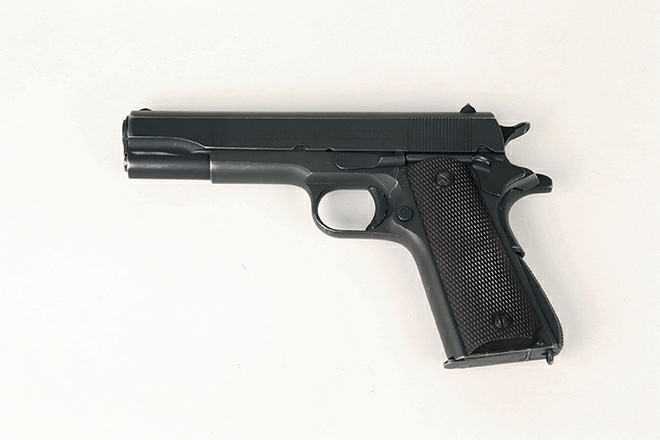 |
M1911A1 PistolFirst designed by John Browning in 1911, this .45 caliber semi-automatic pistol was issued to D-Day officers and enlisted men working on larger weapons crews. Ammo came in a seven-round magazine, and a soldier typically jumped with 21 rounds total -- seven in a loaded gun, plus two two more clips in his pouch. “The .45 caliber round had considerable stopping power,” Czekanski says. “The intention is that when it hits someone, it will knock them over.” While not all paratroopers were issued M1911A1s -- “mostly only officers and maybe someone with a Browning machine gun,” Czekanski says -- almost two million of these pistols were ordered by the government for the overall war effort. Manufacturers included Remington, Colt, Ithaca Gun Company, and Union Switch & Signal. Even Singer -- yes, the sewing machine company -- fulfilled an order for 500 pistols as part of an experiment to see how quickly a company with zero weapons-making experience could become a military supplier. Today, the Singer M1s are extremely rare (and expensive) auction items. This one was estimated to fetch anywhere between $20,000 and $40,000 |
Thompson Sub-machine GunAlready popular among bootleggers and gangsters of the 1920s, the fully automatic Thompson sub-machine gun was also a key weapon for D-Day paratroopers. The gun’s effective range was only 160 feet, but the paratroopers needed a rapid-fire weapon with superior knockdown power for the close combat they were expected to encounter. The Thompson SMG used the same .45 caliber bullets of the M1911A1 pistol. The army spec’d 20-round “box” magazines; a soldier may jump with 300 rounds total via 15 magazines hidden in the pockets of his jumpsuit. While gangsters are romantically portrayed with circular “drum” magazines for their Tommy guns, the military preferred box magazines (as shown here), which were less rattly, and much easier to attach and detach during the heat of combat. ”Maybe one in 10 guys would have a Thompson,” Czekanski says. “They would have gone to squad leaders, company commanders, officers -- officers had free choice on what they could have. They were great for close action like clearing building. You could pull the trigger, and move a bit to sweep the trail ahead.” |
|
Luminous DiscThese luminous buttons -- pictured here next to the wrist compass to give you an idea of their size -- contained radium, the same toxic, radioactive material used in early glow-in-the-dark wrist watches. The discs were issued to squad leaders, and were intended to be clipped or strapped on the back of helmets, jacket collars, and other parts of a soldier’s uniform. A paratrooper “charged” the disc by shining a light on it, and then the device could be used for hours as a subtle beacon to keep fellow soldiers within sight. “You used it to follow the guy ahead of you,” says Czekanski. “You didn’t have to be right behind the guy when he’s walking down the path in order to see him.” Both the Brits and the Americans used the luminous discs, but only the Yankee versions were marked “poison inside.” The discs, sometimes referred to as “deck markers,” were also shipped in lead-lined containers. |
|
Foot LockersThe US Army during WWII used primarily three designs of enlisted man's footlockers, an example of each is shown at left. |
|
Fighting Fox Company ~ News & Events |
-
2019 Berwick WWII Weekend - 4th Annual






-
2019 Mid-Atlantic Air Museum WWII Weekend




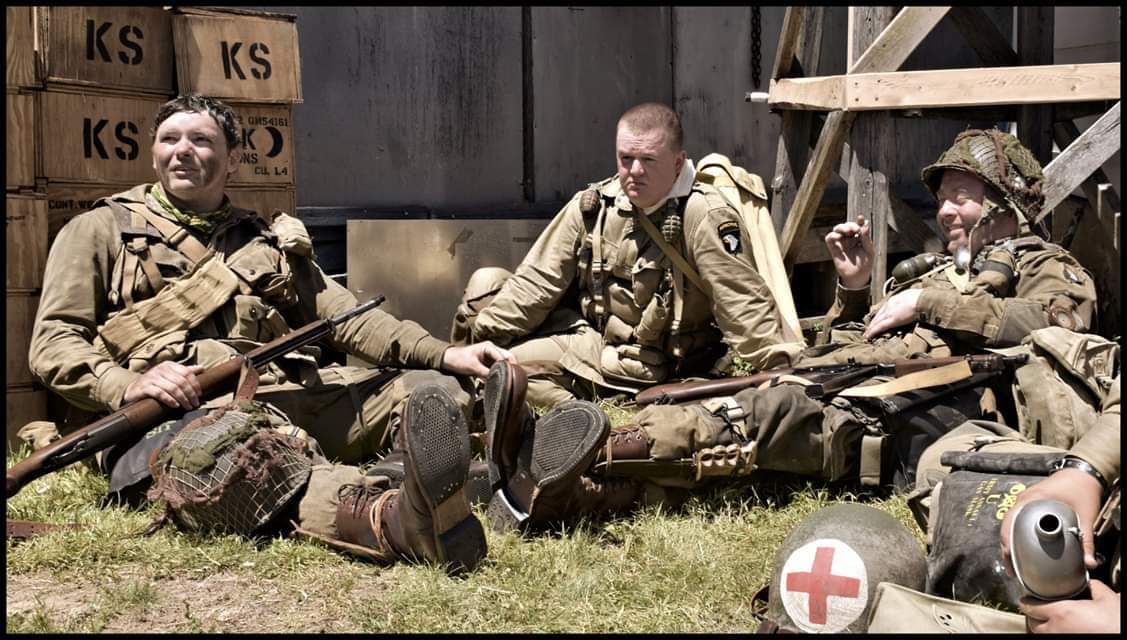





-
Berwick, PA - Berwick WWII Weekend 2018
A good turnout for the "3rd Annual - Berwick WWII Weekend". This was Fighting Fox's first attendance of this show, but this event which will surely grow larger in the future.
See more pictures from this event: Click Here







.png)
-
Mid-Atlantic Air Museum's - WWII Weekend
The Mid-Atlantic Air Museum's annual "WWII Weekend" (MAAM website-Click Here)
Always a good show and a very good time.


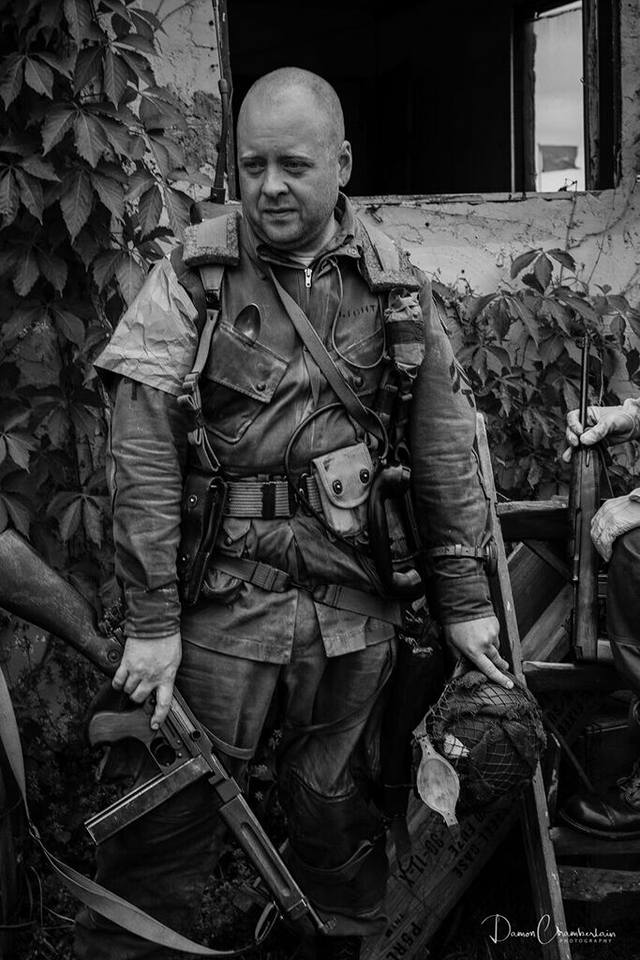

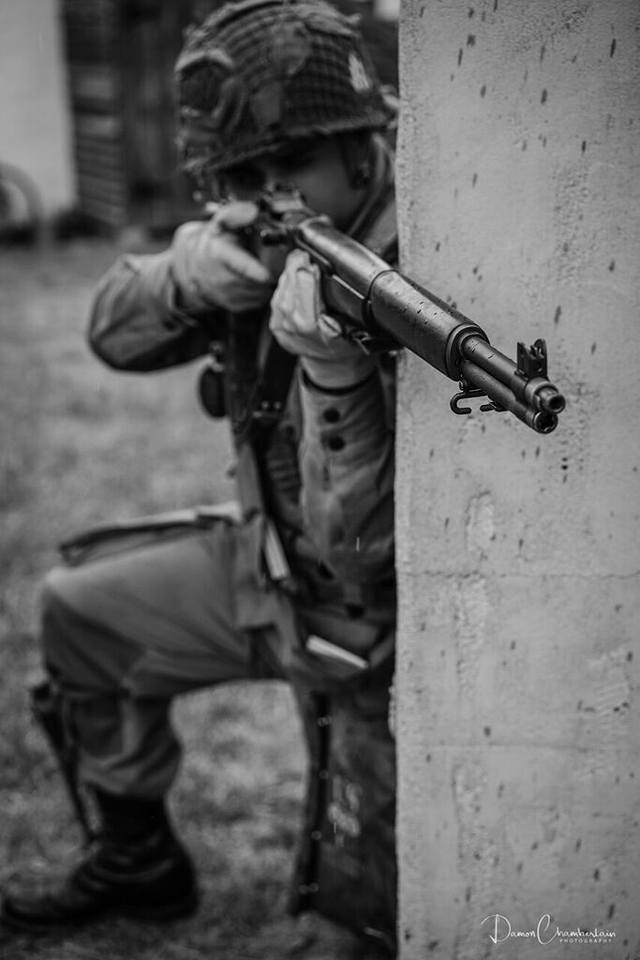

.png)
-
Fort Indiantown Gap (FIG) 2018
Fort Indiantown Gap (FIG) WWII Re-Enactment.
A good turnout of 15 members and an excellent impression was observed and reported to us by many other units. An excellent weekend to say the least. To see more pictures: Click Here


